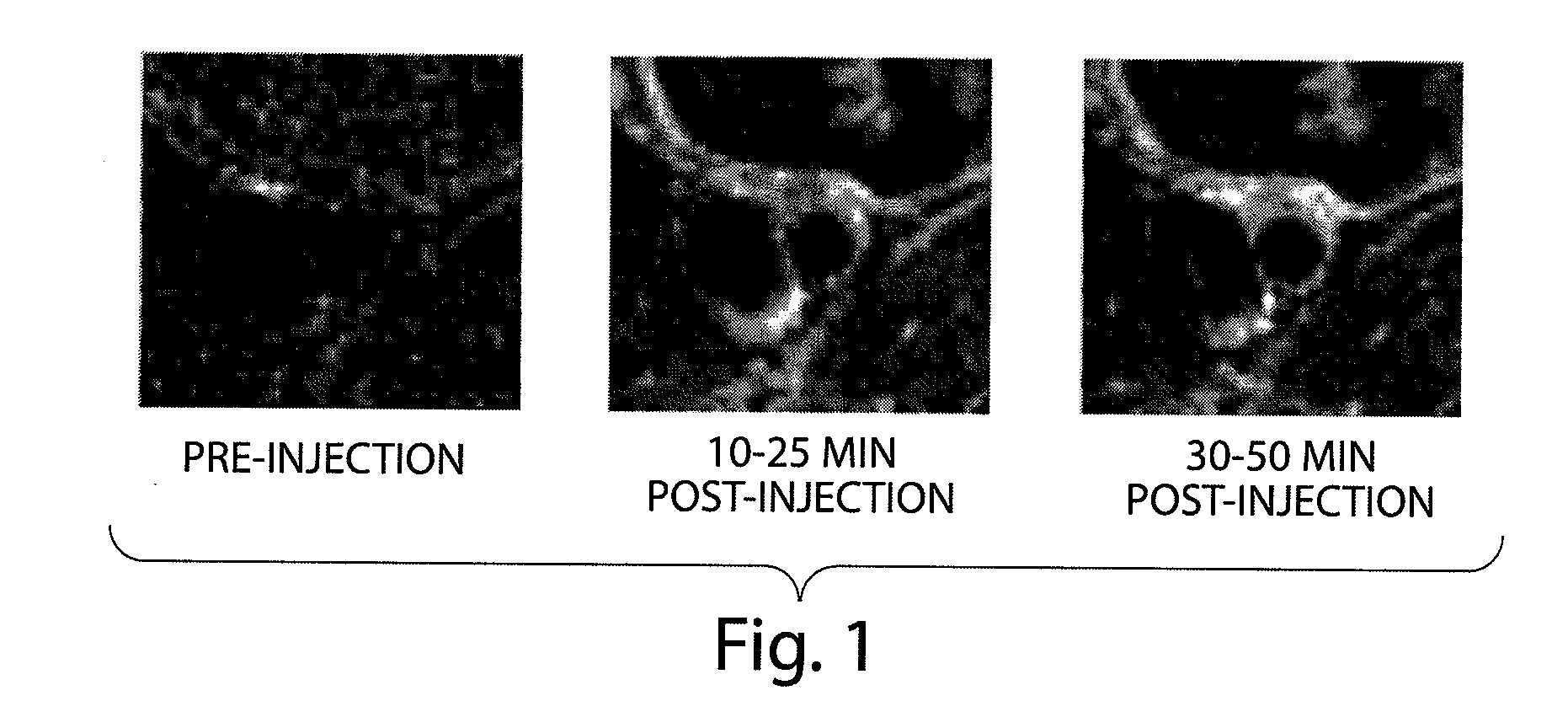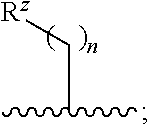N-alkoxyamide conjugates as imaging agents
a technology of alkoxyamide and conjugates, applied in the field of compound and diagnostic agents, can solve the problems of unsatisfactory imaging of coronary or even carotid lesions, many unanswered questions,
- Summary
- Abstract
- Description
- Claims
- Application Information
AI Technical Summary
Benefits of technology
Problems solved by technology
Method used
Image
Examples
example 1
2-{[2-({[N-({4-[((2R)-2-amino-4-phenylbutanoylaminooxy)methyl]phenyl}methyl)carbamoyl]methyl}{2-[bis(carboxymethyl)amino]ethyl}amino)ethyl](carboxymethyl)amino}acetic acid, trifluoroacetic acid salt
[0317]
Part A
Preparation of N-(1-(N-hydroxycarbamoyl)(1R)-3-phenylpropyl)(tert-butoxy)-carboxamide
[0318]
[0319]A solution of Boc-DHfe-OH (1.40 g, 5.00 mmol) in 4:1 CH2Cl2 / MeOH (25.0 mL) was treated with (trimethylsilyl)diazomethane (6.00 mmol; 3.00 mL of a 2.0 M solution in Et2O) dropwise over 0.25 h at 22° C. CAUTION: vigorous gas evolution. The resulting yellow solution was stirred an additional 0.25 h to ensure complete methylation (Rf=0.7 in 1:1 EtOAc / hexanes). Excess (trimethylsilyl)diazomethane was consumed by the dropwise addition of glacial AcOH, then all volatiles removed in vacuo. The crude ester was redissolved in MeOH (25.0 mL), cooled to 0° C. and treated with a previously prepared suspension of H2NOH.HCl (1.04 g, 15.0 mmol) and KOH (1.68 g, 30.0 mmol) in MeOH (25.0 mL); a larg...
example 2
2-(7-{[N-({4-[((2R)-2-amino-4-phenylbutanoylaminooxy)methyl]phenyl}methyl)carbamoyl]methyl}-1,4,7,10-tetraaza-4,10-bis(carboxymethyl)cyclododecyl)acetic acid, trifluoroacetic acid salt
[0331]
[0332]A solution of 2-(1,4,7,10-tetraaza-4,7,10-tris {[(tert-butyl)oxycarbonyl]methyl}-cyclododecyl)acetic acid (109 mg, 0.190 mmol) in dry DMF (10.0 mL) was successively treated with HOBt (29.0 mg, 0.190 mmol), HBTU (71.9 mg, 0.190 mmol) and i-Pr2NEt (40.8 μL, 0.234 mmol) at 22° C. After 0.25 h, the solution was treated with the product of Part 1D (0.158 mmol; 5.80 mL of a 0.027 M solution in DMF) and the resulting solution stirred 3 h. To complete conversion the solution was further treated with 30 mol % of the active ester, stirred 0.25 h, then diluted with EtOAc (75 mL) with transfer to a separatory funnel. The EtOAc solution was washed with 0.1 M citric acid (3×75 mL), followed by saturated aqueous solutions of NaHCO3 and NaCl (3×75 mL each), then dried over MgSO4, filtered and concentrated ...
example 3
2-{[2-({[N-({4-[((2S)-2-amino-4-phenylbutanoylaminooxy)methyl]-phenyl}methyl)carbamoyl]methyl}{2-[bis(carboxymethyl)amino]ethyl}amino)ethyl]-(carboxymethyl)amino}acetic acid, trifluoroacetic acid salt
[0334]
Part A
Preparation of N-(1-(N-hydroxycarbamoyl)(1S)-3-phenylpropyl)(tert-butoxy)-carboxamide
[0335]
[0336]A suspension of H-Hfe-OH (1.79 g, 10.0 mmol) in 2:1 THF / H2O (50.0 mL) was treated with Na2CO3 (2.54 g, 24.0 mmol) followed by Boc2O (2.62 g, 12.0 mmol) in one portion at 22° C. After 1 h the heavy suspension was acidified to pH 3-4 using 0.1 M HCl, and the resulting homogeneous solution transferred to a separatory funnel and washed with EtOAc (4×50 mL). The combined EtOAc washes were dried over MgSO4, filtered and concentrated in vacuo to a colorless oil that was used without further purification in subsequent reactions.
[0337]A solution of crude Boc-Hfe-OH (10.0 mmol theoretical) in 4:1 CH2Cl2 / MeOH (50.0 mL) was treated with (trimethylsilyl)diazomethane (12.0 mmol; 6.00 mL of a 2...
PUM
 Login to View More
Login to View More Abstract
Description
Claims
Application Information
 Login to View More
Login to View More - R&D
- Intellectual Property
- Life Sciences
- Materials
- Tech Scout
- Unparalleled Data Quality
- Higher Quality Content
- 60% Fewer Hallucinations
Browse by: Latest US Patents, China's latest patents, Technical Efficacy Thesaurus, Application Domain, Technology Topic, Popular Technical Reports.
© 2025 PatSnap. All rights reserved.Legal|Privacy policy|Modern Slavery Act Transparency Statement|Sitemap|About US| Contact US: help@patsnap.com



